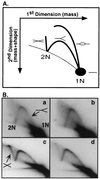The high mobility group protein Abf2p influences the level of yeast mitochondrial DNA recombination intermediates in vivo
- PMID: 9618482
- PMCID: PMC22617
- DOI: 10.1073/pnas.95.12.6739
The high mobility group protein Abf2p influences the level of yeast mitochondrial DNA recombination intermediates in vivo
Abstract
Abf2p is a high mobility group (HMG) protein found in yeast mitochondria that is required for the maintenance of wild-type (rho+) mtDNA in cells grown on fermentable carbon sources, and for efficient recombination of mtDNA markers in crosses. Here, we show by two-dimensional gel electrophoresis that Abf2p promotes or stabilizes Holliday recombination junction intermediates in rho+ mtDNA in vivo but does not influence the high levels of recombination intermediates readily detected in the mtDNA of petite mutants (rho-). mtDNA recombination junctions are not observed in rho+ mtDNA of wild-type cells but are elevated to detectable levels in cells with a null allele of the MGT1 gene (Deltamgt1), which codes for a mitochondrial cruciform-cutting endonuclease. The level of recombination intermediates in rho+ mtDNA of Deltamgt1 cells is decreased about 10-fold if those cells contain a null allele of the ABF2 gene. Overproduction of Abf2p by >/= 10-fold in wild-type rho+ cells, which leads to mtDNA instability, results in a dramatic increase in mtDNA recombination intermediates. Specific mutations in the two Abf2p HMG boxes required for DNA binding diminishes these responses. We conclude that Abf2p functions in the recombination of rho+ mtDNA.
Figures




References
Publication types
MeSH terms
Substances
Grants and funding
LinkOut - more resources
Full Text Sources
Molecular Biology Databases

